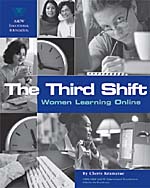Book Review: Third Shift: Women Learning Online
Third Shift: Women Learning Online (2001) addresses a critical yet neglected
issue in American distance education literature; the challenge of women distance education students to balance their studies with work and family responsibilities. The work was sponsored by the American Association of University Women and conducted by Cheris Kramarae, an expert on women, technology and policy. As women comprise the majority of online learners, Third Shift is significant for policymakers, distance educators, researchers and online students. Kramarae and her assistants interviewed 64 women and 36 men, conducted focus groups of 27 participants and surveyed 410 online respondents. Both women and men recounted their experiences and attitudes as students, educators, participants and observers of online learning. Although not a representative sample of US distance learners, Kramarae presents the reality of the range of women’s experiences and challenges as online learners. Her "focus . . . is on researching perspectives and recurring themes expressed by the respondents" (p.6). These themes include women’s domestic responsibilities, time, finances and online communications. Kramarae raises a crucial issue that has been stressed in studies of adult women students; the lack of social and financial support for domestic activities such as childcare. "In the United States, women still perform 70 to 80 percent of childcare, which, of course, affects how much time they can spend on paid work and education . . . with important implications for everyone in our country. Because it is seldom discussed as such, however, women are left to work out individual solutions" (p. 31). It is noted, however, that not all women students face this challenge, such as younger women with no children or family responsibilities. There are also married women who are encouraged by their spouses. "Several dozen women note the importance of receiving active support and encouragement from partners and children, and several mention that they receive technical help from their partners as well" (p. 34). Women have also received "passive support from spouses, for example, not being interrupted a lot while they are studying or not being made to feel guilty" (p. 34). Third Shift also illuminates factors such as gender dynamics of online discussions and chat. Kramarae offers a survey of accounts; some women feel the online communication is productive, while others feel ignored. Kramarae expands beyond the view that online discussions allow for a more democratic atmosphere, "several dozen respondents state that old bases for judgment and bias may be replaced with new cues, especially those of writing style and content" (p.47). She emphasizes the need for instructors to moderate online discussions to ensure a fair environment where all contribute and voice their opinions. Kramarae also recognizes a consistent finding that older women do not express the need for face-to-face interaction as much as younger women. "Age emerges once again as a critical issue, with older students likely to minimize the importance of social experiences or interaction in the classroom" (p.52). Interestingly, Kramarae found that "teachers, more than online students, stress the importance of learning as a social activity. Furthermore, she finds some "women experience traditional classes as lonely and isolating, especially if they commute to campus" (p.52). It has been argued by distance education experts that the definition of distance education be expanded to account for the context of the learners’ lives. Kramarae advises policymakers and educators to take this into account to optimize student success. A first step, she argues, is to address financial needs. Tuition and other educational costs can be a major challenge for women, especially single mothers. Costs also overflow to the purchase of optimal computers and Internet access. Policies facilitating computer purchasing and access to online academic databases can contribute to a solution. Kramarae urges national and university policymakers to respect these needs, emphasizing "Adult women’s education has not been a major political priority, although women’s participation in the workplace has been recognized as critical for the national good" (p. 58). Third Shift is a realistic account of the social and economic contexts of women’s online learning experiences. In the 1980s, this subject had begun to be investigated in other countries such as Canada, European and Asian nations. Kramarae has illuminated pertinent issues in the lives of American women. Third Shift, Women Learning Online provides a valuable resource to promote the positive social consequences of online distance education. Association of University Women Publication Sales Catalog |









